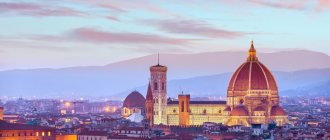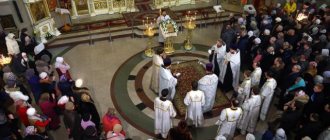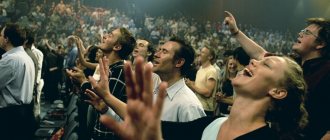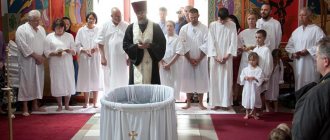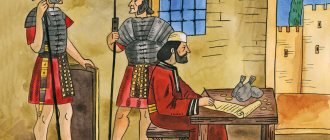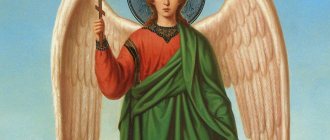We often hear the expression “Greek Catholic Orthodox Church.” This raises many questions. How can the Orthodox Church be Catholic at the same time? Or does the word “catholic” mean something completely different? The term “orthodox” is also not entirely clear. It is applied to Jews who carefully adhere to the requirements of the Torah in their lives, and even to secular ideologies. For example, you may hear the expression “orthodox Marxist.” At the same time, in English and other Western languages, “orthodox church” is synonymous with “orthodox”. What's the secret here? We will try to clarify the ambiguities associated with the Orthodox (Orthodox) Church in this article. But to do this, you first need to clearly define the terms.
Orthodoxy and orthopraxy
Jesus told His disciples: “Whoever follows My commandments and lives according to them, I will liken him to a wise man who built a house on the rock. But the one who divides the commandments but does not fulfill them, I will liken him to a foolish man who builds a dwelling on the sand” (Matt. 7:24-26). What does this phrase have to do with orthodoxy and orthopraxy? Both terms contain the Greek word orthos. It means "right, straight, right." Now let's look at the difference between orthodoxy and orthopraxy.
The Greek word doxa means "opinion, doctrine." And “praxia” corresponds to the Russian term “practice, activity.” In light of this, it becomes clear that orthodoxy means correct doctrine. But is this enough? Those who listen to and share the teachings of Christ can be called orthodox. But in the early church the emphasis was not on correct doctrine, but on keeping the commandments—“righteous living.” However, at the end of the third century, a canon, a religious dogma, began to be created. The Orthodox Church began to prioritize the division of the correct teaching, the “right glorification of God.” But what about fulfilling the commandments? Orthopraxy somehow gradually faded into the background. Strict adherence to all ideological prescriptions of the Church has historically turned out to be more important.
Orthodoxy in today's society
Knowing what Orthodoxy is and imagining a Jew professing Judaism, people have bad associations when faced with words that have the root Orthodox. The point is not only a negative attitude towards Judaism.
Those who think orthodoxly and blindly follow scripture or authority are generally unable to think for themselves. Such people cannot adapt to the dynamics of the world, analyze and compare facts regarding their preferences. In part, they are zombies, following a strictly limited path through life, because they consider it to be true - the only true one.
For some areas of human activity, where little changes (legislation, some areas of management), following established canons is even necessary for the successful performance of work. Nothing bad can be said about communities that adhere to orthodox views regarding lifestyle, living and living like their ancestors hundreds of years before.
There is a concept of “orthodox medicine”. This is what osteopaths call modern medicine, which divides the human body into organs and their systems. This prevents highly specialized specialists from assessing the situation as a whole, which is the reason for the incurability of a number of diseases.
Orthodoxy and heterodoxy
As we already mentioned, the term itself appeared in Christianity at the end of the third century. It is used by apologists, including Eusebius of Caesarea. In his History of the Church, the author calls Clement of Alexandria and Irenaeus of Lyons “ambassadors of orthodoxy.” And immediately this word is used as an antonym to the term “heterodoxy”. It means "other teachings." All views that the church did not accept into its canon were rejected as heretical. Since the reign of Justinian (6th century), the term “orthodoxy” has been used quite widely. In 843, the church decided to call the first Sunday of Lent the day of the triumph of Orthodoxy.
Other Christian teachings, even if their followers adamantly followed and fulfilled the commandments of Jesus, were condemned at the Councils. Heterodoxy is increasingly being called heresy. Followers of such Christian denominations are persecuted by repressive institutions such as the Inquisition and the Synod. In 1054, the final split between Western and Eastern Christianity occurred. The term “orthodox church” began to refer to the teachings of the Patriarch of Constantinople.
Orthodox direction in religion
They are considered to be religious movements that originated from the biblical Abraham: Christianity, Judaism, Islam (Sunni direction).
Judaism
Why is Orthodoxy associated specifically with Jews and Judaism? The point is the emergence of a new movement of Judaism that arose in the 19th century. Those who did not abandon the previous faith, which had existed for thousands of years in almost unchanged form, were called orthodox. These people blindly followed the scripture, believing it to be 100% correct, and did not even try to change anything in it.
Orthodox adherents of Judaism believe that their religious preferences allow them to live in harmony with the world around them, their own mind and conscience. They do not hesitate to flaunt their personal beliefs even in modern society. Orthodox Jews stand out in the crowd due to their behavioral reactions, preferences in food, clothing, and wearing religious symbols.
Jews with children
As the next stage in the development of such Judaism, Orthodox modernism appears, which not only preserves the old principles, but also integrates them with modern culture.
Christianity
The next orthodox Abrahamic religion is Christianity. It is distinguished by its strict adherence to traditions and rituals (services are held standing, men remove their hats, fasting), and blind adherence to the doctrine approved by church officials.
The word ὀρθοδοξία, from which orthodoxy is derived, can be found in the works of the Anglican saint and Christian apologist Clement of Alexandria. Eusebius of Caesarea also writes about him in his “Ecclesiastical History.” Under the reign of Justinian in the mid-500s AD, orthodox were people who held theological views that exactly corresponded to the contents of the Gospel and the provisions approved by the church.
Preacher
Orthodox schools of the East
Characteristic of India, where people over the course of thousands of years have acquired a number of philosophical and religious movements. A significant part of them, unlike Judaism, Christianity and other Abrahamic religions, are based on facts, historical experience, science, and not on sacred texts. Many orthodox Eastern religions and philosophies exist at the intersection of all of the above concepts.
The largest number of followers are:
- Yoga is a set of diverse practices: spiritual, physical, mental. Through meditation, you can get closer to God and reunite with him, because every soul is a part of the creator himself.
- The so-called numerical orthodox philosophy of Sankhya, its basis is the distraction of the spirit from the mother. These substances are the basis of everything that exists.
- Purva Mimamsa is an orthodox Indian school of philosophy, its purpose is to explain the nature of dharma, which man cannot understand on his own, but is given by the Vedas (ancient Indian scriptures). Their followers of the school consider them true and infallible due to the absence of an author. The Vedas are of divine origin, which means their authority is unshakable.
- Nyaya is one of the 6 main Indian schools of philosophy, based on logic and bordering on Buddhism.
- Vaisheshika - states that everything, including humans, consists of tiny indivisible particles. They always exist and are controlled by God himself.
Yoga class in the garden
Orthodox schools are also characteristic of China - Confucianism - an ethical and philosophical teaching created by the Chinese thinker Confucius half a millennium before the birth of Christ. It acquired followers in other Eastern countries: Japan, Korea. Due to the establishment as a state ideology in the 2nd century BC. divided into two branches: the orthodox one, called the “School of the Canon of Ancient Signs” and the unorthodox one – the “School of the Canon of Modern Signs”. Followers sacredly honor the precepts and authority of Confucius and his disciples.
Orthodox schools are also inherent in the West - orthodox Marxism - the development of the works of Karl Marx and Friedrich Engels by their followers. The basis of the teaching is that all the laws of social development of Marx and Engels are irrefutable and correct due to their practical validity (time has shown that this is not so).
Orthodox Freudian psychoanalysis
Freudianism is an authoritative movement of psychoanalysis developed by Sigmund Freud. He claims that the basis for the development of personality is his animal nature - instinctive drives - aggressive and sexual. Due to the prohibitions of the surrounding world on their satisfaction, these drives move into the area of the unconscious person and drive him.
Freudianism is considered orthodox due to the development of psychoanalysis by Freud, despite the fact that the scientist himself attributes all the merits to J. Breiner, a doctor from Vienna.
Sigmund Freud
Catholicity - what is it?
Christ said to his disciples: “Where two or three are gathered together in My name, there I will also be among them” (Matthew 18:20). This means that there is a church wherever there is at least one community, even the smallest one. “Catholicity” is a Greek word. It means “whole”, “universal”. Here we can also remember the covenant that Jesus gave to his apostles: “Go, preach to all nations.” In a geographical sense, catholicity means “universality.”
Unlike the contemporary of the early church, Judaism, which was the national religion of the Jews, Christianity claimed to embrace the entire ecumene. But the universality of catholicity also had another meaning. Every part of the church possessed the fullness of holiness. This position was shared by both directions of Christianity. The Roman Church began to be called Catholic (Catholic). But its canon asserted the supreme power of the pope as Christ's vicar on earth. The Greek Catholic Orthodox Church also claimed to spread throughout the world. However, even though it was headed by the patriarch, the local churches had complete independence from each other.
OpenTown Open city
STOLE ORTHODOXY
Orthodox Rus', before and after the adoption of Christianity
The name Orthodox itself was assigned by Christian hierarchs in the 11th century (1054 AD) during a split into the Western and Eastern churches. The Western Christian Church, centered in Rome, began to be called Catholic i.e. Ecumenical, and the Eastern Greek-Byzantine Church with its center in Constantinople (Constantinople) Orthodox i.e. Faithful. And in Rus', the Orthodox adopted the name of the Orthodox Church, because... Christian teaching was forcibly spread among the Orthodox Slavic peoples. There is an error in the very phrase “Christian Orthodoxy.” Correctly, the Russian Orthodox Church should sound like the Orthodox Autocephalous Church of the Byzantine sense. Orthodoxy is not a religion, not Christianity, but FAITH! Modern scientists, historians and theologians of the Russian Orthodox Church argue that Rus' became Orthodox only thanks to the baptism of Rus' and the spread of Byzantine Christianity among the dark, wild, mired in paganism of the Slavs. This formulation is very convenient for distorting history and belittling the significance of the most ancient culture of all Slavic peoples. The word Orthodoxy is not in the Bible. It is a fact. It is not found in other, non-Slavic languages either. But Wiki, like the priests, insist that Orthodoxy = ὀρθοδοξία = Orthodoxy. Let's try to figure out what Orthodoxy and Orthodoxy are! For example, translated into English, Orthodoxy is identified with the Eastern Orthodox Church! By the way, there are a whole lot of these so-called Orthodoxies! Let's say there is the Orthodox Catholic Church. Is this some type of Orthodox Catholic Church? How do you like the Ethiopian Orthodox Church? Here is another striking example: Russian Orthodox Church is the Russian Orthodox Church, but Orthodox Judaism is no longer, as you might think, Orthodox Judaism, but Orthodox Judaism, as it should be! This means that Orthodoxy is not Orthodoxy! Orthodoxy is orthodoxy. And then everything falls into place! Orthodoxy Material from Wikipedia - the free encyclopedia: Orthodoxy (tracing paper from Greek ὀρθοδοξία - literally correct judgment, correct teaching or correct glorification [1]) - a direction in Christianity that took shape in the east of the Roman Empire during the 1st millennium from the Nativity of Christ, under the leadership of with the main role of the department of the bishop of Constantinople - New Rome. Orthodoxy (tracing paper with Greek ὀρθοδο eng - literally correct judgment, correct teaching or proper glorification of tracing paper (linguistics) material from Wikipedia - free encyclopedia: heel (from French Calque - copy) “Pendant” - this is a copy, i.e. is identical to Orthodoxy ( tracing paper from the Greek ὀρθοδοξία - literally correct judgment, correct teaching or correct glorification The Orthodox Catholic Church is also the Orthodox Catholic Church? The Ethiopian Orthodox Church (Ethiopian Orthodox Tewahedo Church) Well, so is Judaism orthodox, so is Islam ... All Orthodox? Ha! Ha! Ha! This is what happens when you lie! The Greek-Catholic Orthodox (Right Faithful) Church (now the Russian Orthodox Church) began to be called Orthodox only on September 8, 1943 (approved by Stalin’s decree in 1945). The name Russian Orthodox the church was accepted as official only in the fall of 1943. The Russian Orthodox Church (Moscow Patriarchate) was registered as a religious organization on February 27, 2003. And before that, the name of the Christian church in Russia, before its abolition by the communists, sounded as follows: Greek-Catholic Church (Ecumenical Church of the Greek Rite). After Nikon's reform and the replacement of the word orthodox with the word orthodox in the liturgical books, in 1700 new words were added to the name of the official church: Russian Orthodox Greek Catholic Church. And the name of the official church, known today, the Russian Orthodox Church, appeared by decree of Stalin in 1943 and was approved at a local council held by officers of the NKVD of the USSR. I advise you to carefully read the preamble to the federal law on freedom of conscience and on religious associations, adopted on September 26, 1997. Please note the following points in the preamble: Recognizing the special role of Orthodoxy in Russia...
and further respecting Christianity, Islam, Judaism, Buddhism and other religions... Thus, the concepts of Orthodoxy and Christianity are not identical and carry completely different concepts and meanings. Byzantine monk Belisarius 532 AD. Long before the baptism of Rus', this is what he wrote in his Chronicles about the Slavs and their ritual of visiting the bathhouse: Orthodox Slovenians and Rusyns are wild people, and their life is wild and godless, men and women lock themselves together in a hot, heated hut and exhaust their bodies... We will not pay attention to the fact that for the monk Belisarius the usual visit to the bathhouse by the Slavs seemed something wild and incomprehensible; this is quite natural. Something else is important for us. Pay attention to how he called the Slavs: Orthodox Slovenes and Rusyns. For this one phrase alone we must express our gratitude to him. Since with this phrase the Byzantine monk Belisarius confirms that the Slavs were Orthodox many thousands of years before their conversion to the Judeo-Christian faith. Chetyi Menaion 1714 Read the last 2 lines
https://dic.academic.ru/dic.nsf/ruwiki/1037244 Christians became Orthodox in the 17th century during the reform of Patriarch Nikon (before Nikon there was still dual faith - Orthodoxy and Orthodoxy), who ordered changes to be made in the chronicles. When the Church split in 1054, the western one began to be called “Roman Catholic, Ecumenical” with its center in Rome, and the eastern “Greco-Facolic, Orthodox (Orthodox)” with its center in Constantinople (Constantinople). (“orthodoxy” - “orthodoxy” in Greek). Before the revolution of 1917, the Orthodox Catholic Greek-Russian Church. Afterwards it began to be divided into Old Church and Renovationist. The name Russian Orthodox Church was adopted in the fall of 1943, which was joined by renovationists who self-liquidated in 1946. After 2000 years of Christianity, it is natural to ask the question: Has it solved at least one global problem of humanity? . No, but it has also given rise to many sects and warring peoples. So why are we being dragged with Christianity into the 21st century? An alien religion is hostile. “Orthodox” are all Israelis, although most often they don’t even suspect it. For the “Orthodox” the holy land is not Rus', not the homeland, but Israel. Stoleshnikov (In this case, “Orthodox” means “Orthodox Christians”) In fact, true Orthodoxy is not a religious cult. It was a teaching about how the world around us works and how to interact with it correctly. This was not prejudice, as they tried to convince many people during the USSR, when the existence of God was denied. This was not a backward and primitive cult of idolaters, as the modern Russian Orthodox Church is trying to convince us. “It was real reliable knowledge about the world around us.” Svetlana Lisichkina “ In times of universal lies, telling the truth is extremism ” D. Orwell
Orthodoxy and Catholicism
All Christian denominations, by definition, claim to spread their religion throughout the earth, regardless of the nationality of the believers. And in this sense, Orthodoxy, Catholicism and Protestantism are of the same opinion. What is the Russian Orthodox Church? This issue should be given closer attention. But for now we will focus on the problem of the difference between the Orthodox and Catholic churches.
Until the beginning of the second millennium it did not exist at all. Therefore, the apologists of Christianity of the first centuries, the Church Fathers and saints who lived before 1054 (the final schism), are revered both in Catholicism and in Orthodoxy. Beginning at the end of the first millennium, the Roman Curia claimed more and more power and wanted to subjugate the remaining bishoprics. The process of mutual alienation culminated in the Great Schism, as a result of which the Pope and the Patriarch of Constantinople called each other schismatics. The Fourth Lateran Council of the Roman Church defined the Orthodox as heretics.
Orthodox psychoanalysis: the legacy of the great Freud
This concept also appears in psychology. This is another name for Freudianism - a direction that was started by the Austrian psychologist and psychiatrist Sigmund Freud. Here we mean the teaching in the form in which it was created at the beginning of the 20th century, the classic, original version.
At the center of Freud's teaching is the idea that the main driving force of personality development is instinctual drives. Due to prohibitions and restrictions, they move into the realm of the unconscious.
Orthodox psychoanalysis stands on “ three pillars ”:
- It is an instinct that requires satisfaction, in other words, it is unconscious.
- The superego is a “censor” that forms personal limitations (parental prohibitions, moral standards, self-control, etc.).
- I am a “reconciler” between what is desirable and what is acceptable, developing defense mechanisms. In a broad sense, this is a person’s personality, his rational beginning.
In orthodox psychoanalysis, these are principles hostile to each other.
Neo-Freudians accept the scheme of the Id - Super-Ego - Ego, but see their relationship not so radically, allowing for the possibility of cooperation and harmony.
Ordination
In the Orthodox Church, as well as in Catholicism, great importance is attached to the sacrament of ordination. This word, like many other church terms, comes from the Greek language. The rite of ordination elevates a person to the rank of priesthood, gives him the grace of the Holy Spirit and the right to perform the liturgy.
It is believed that the Church of God was founded by the Lord Himself on the day of Pentecost. Then the apostles were filled with the Holy Spirit. According to the commandment given to them by Christ, they went to different parts of the earth to preach the new faith “to all languages.” The apostles passed on the grace of the Holy Spirit to their successors through ordination.
After the Great Schism, the bishops of the Catholic and Orthodox churches “did not communicate Eucharistically.” That is, they did not recognize the sacraments given by their opponents as effective. After the Second Vatican Council, "partial Eucharistic communion" was achieved between these churches. Therefore, in some cases, joint liturgies are served.
What is Orthodox?
This word is of French origin; in Hugo's language it sounds like orthodoxal. Historically, it goes back to Greek: ὀρθοδοξία means “correct teaching”, “ orthodoxy ”, “ὀρθός” is translated as “straight”, “correct”.
In the general understanding , orthodox is a person who unswervingly and consistently adheres to the foundations of some worldview, doctrine, concept (what is this?), faithfully following his worldview.
The synonyms offered by the explanatory dictionary will help complement the meaning of this word:
- traditional;
- consistent;
- outdated;
- inert;
- verified;
- orthodox.
A person who holds orthodox ideas is called an orthodox .
Here, for many, the image of a Jewish man with a specific appearance comes to mind, and there is an explanation for this.
The word “Orthodox” came into use at the end of the 18th century: this is how enlightened Jews in Germany called those who resisted changes in religious and social life. From their lips it sounded with a tinge of contempt.
Those times have sunk into oblivion: in the Russian language dictionary edited by Ushakov there is not even a hint of a man in black clothes who only accepts kosher food and does not work on Saturday, in connection with this word.
In the modern understanding, an orthodox is someone who scrupulously adheres to a point of view accepted as the only correct one. In other words, he has orthodox views.
There are also more interesting cases of using the word “orthodox”. For example, you can hear it... in a pharmacy!
This is a distorted version of the word “Arthrodex” - the name of a popular ointment for treating joints.
How the Russian Orthodox Church was formed
Tradition claims that the Apostle Andrew the First-Called preached and spread the Christian faith in the Slavic lands. He did not reach the lands where the Russian Federation is now located, but he baptized people in Romania, Thrace, Macedonia, Bulgaria, Greece, and Scythia.
Kievan Rus adopted Greek-style Christianity. Patriarch Nicholas II of Constantinople, Chrysoverg, ordained Michael as the first metropolitan. This event took place in 988, during the reign of Prince Vladimir Svyatoslavovich. For a long time, the metropolitanate of Kievan Rus remained under the jurisdiction of the Greek Orthodox Church.
In 1240 there was an invasion of the Tatar-Mongol hordes. Metropolitan Joseph was killed. His successor, Maxim, moved his throne to Vladimir on the Klyazma in 1299. And his heirs in Christ, although they called themselves “metropolitans of Kyiv,” actually lived on the territory of the Moscow appanage principality. In 1448, there was a complete dissociation of the Moscow Metropolis from the Kyiv Metropolitan by a resolution of the Council, dominated by Bishop Jonah of Ryazan, who proclaimed himself “Metropolitan of Kyiv” (but in fact, of Moscow).
Kiev and Moscow Patriarchate - is there a difference?
The event that took place remained without the blessing of the Patriarch of Constantinople. Ten years later, the next Council clearly expressed a complete break with Kyiv. Jonah's successor, Theodosius, began to be called "Metropolitan of Moscow and All Great Russia." But this religious-territorial unit was not recognized by other Orthodox churches for one hundred and forty years and did not enter into Eucharistic communion with it.
Only in 1589 did the Patriarch of Constantinople recognize autocephaly (autonomy within the Orthodox Church) for the Moscow Metropolis. This happened after the Ottomans captured Constantinople. Patriarch Jeremiah II Thranos came to Moscow at the invitation of Boris Godunov. But it turned out that they began to force the guest to ordain a local unrecognized metropolitan as the head of the church. After six months of imprisonment, Jeremiah ordained the Moscow Metropolitan as a patriarch.
Later, with the strengthening of the role of Russia (and the simultaneous decline of Constantinople as the center of Eastern Christianity), the myth of the Third Rome began to be implanted. The Moscow Patriarchate, although it was part of the Orthodox Church of the Greek rite, began to claim primacy among others. He achieved the abolition of the Kyiv Metropolis. But if you do not take into account the disputes over the consecration of the Moscow Patriarch, then in terms of religion these churches are no different from each other.
Dogmas that separate Orthodoxy and Catholicism. Filioque
What does the Orthodox Church profess? After all, judging by the name, it puts “the correct glorification of God” at the forefront. Its canon consists of two large parts: Holy Scripture and Holy Tradition. If everything is clear with the first - these are the Old and New Testaments, then what is the second? These are the decrees of all Ecumenical Councils (from the very first to the Great Schism and then only the Orthodox churches), the lives of the saints. But the main document used in the liturgy is the Nicene-Constantinopolitan Creed. It was adopted at the Ecumenical Council of 325. Later, the Catholic Church adopted the filioque dogma, which states that the Holy Spirit comes not only from God the Father, but also from the Son, Jesus Christ. Orthodoxy does not accept this principle, but shares the indivisibility of the Trinity.
Symbol of faith
The Greek Orthodox Church teaches that the soul can only be saved within its womb. The first symbol is faith in one God and in the equality of all hypostases of the Trinity. Further, religion honors Christ, created before the beginning of time, who came into the world and became incarnate in man, crucified to atone for original sin, resurrected and coming on the Day of Judgment. The Church teaches that its first priest was Jesus. And therefore she herself is holy, one, catholic and immaculate. Finally, at the Seventh Ecumenical Council, the dogma of veneration of icons was adopted.
Orthodox schools of thought
In the countries of the East, everything is different: here this concept does not mean irrelevant, divorced from life, inert, but vice versa. The orthodox “wing” remains in Chinese Confucianism, called the “School of the Canon of Ancient Signs.” His followers defend the inviolability of the authority of Confucius, his disciples, and the immutability of their covenants.
Indian orthodox systems based on the Vedic canons are also known throughout the world: Vedanta, Sankhya, Nyaya, Mimamsa, Yoga, Vaisheshika.
This tendency is also characteristic of Western teachings; a striking example is orthodox Marxism. According to many historians and political scientists, the socialist ideology of the 20th century, called Marxism-Leninism, is, in fact, that very direction.
Liturgy
The Orthodox Church conducts services according to the Byzantine (Greek) rite. It presupposes the existence of a closed iconostasis, behind which the sacrament of the Eucharist is performed. Communion is performed not with a wafer, but with prosphora (leavened bread) and wine (mainly Cahors). Liturgical worship consists of four circles: daily, weekly, fixed and mobile annual. But some Orthodox churches (for example, Antiochian and Russian Orthodox abroad) began to use the Latin rite since the 20th century. Divine services are conducted in the synodal version of the Old Church Slavonic language.
Russian Orthodox Church
After the October Revolution, the Moscow Patriarchate has been in a long canonical and legal conflict with Constantinople. Nevertheless, in Russia the Orthodox Church is the largest religious community. It was registered as a legal entity, and in 2007 the state ordered that all religious property be transferred to it. The ROC MP claims that its “canonical territory” extends to all republics of the former USSR, with the exception of Armenia and Georgia. This is not recognized by Orthodox churches in Ukraine, Belarus, Moldova, Estonia.
